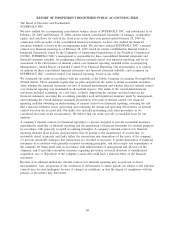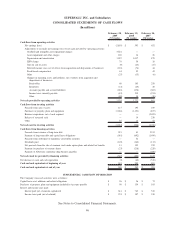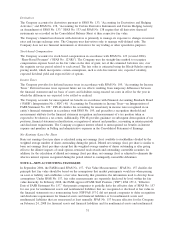Albertsons 2009 Annual Report Download - page 54
Download and view the complete annual report
Please find page 54 of the 2009 Albertsons annual report below. You can navigate through the pages in the report by either clicking on the pages listed below, or by using the keyword search tool below to find specific information within the annual report.
history of losses or a projection of continuing losses, a significant decrease in the market value of an asset or
the Company’s plans for store closures. When such events or changes in circumstances occur, a recoverability
test is performed by comparing projected undiscounted future cash flows to the carrying value of the asset or
group of assets as defined in SFAS No. 144. If impairment is identified for long-lived assets to be held and
used, the discounted future cash flows are compared to the asset’s current carrying value and an impairment
charge is recorded for the excess of the carrying value over the discounted future cash flows. For long-lived
assets that are classified as assets held for sale, the Company recognizes impairment charges for the excess of
the carrying value plus estimated costs of disposal over the estimated fair value. The Company estimates fair
value based on the Company’s experience and knowledge of the market in which the property is located and,
when necessary, utilizes local real estate brokers. Long-lived asset impairment charges are a component of
Selling and administrative expenses in the Consolidated Statements of Earnings.
Deferred Rent
The Company recognizes rent holidays, including the time period during which the Company has access to the
property prior to the opening of the site, as well as construction allowances and escalating rent provisions, on
a straight-line basis over the term of the lease. The deferred rents are included in Other current liabilities and
Other long-term liabilities in the Consolidated Balance Sheets.
Self-Insurance Liabilities
The Company is primarily self-insured for workers’ compensation and general and automobile liability costs.
It is the Company’s policy to record its self-insurance liabilities based on management’s estimate of the
ultimate cost of reported claims and claims incurred but not yet reported and related expenses, discounted at a
risk-free interest rate. The present value of such claims was calculated using discount rates ranging from 1.1 to
5.1 percent for fiscal 2009, 2.4 to 5.1 percent for fiscal 2008 and 4.7 to 5.0 percent for fiscal 2007.
Changes in the Company’s self-insurance liabilities consisted of the following:
2009 2008 2007
Beginning balance $1,132 $ 992 $ 58
Self-insurance liabilities from the Acquired Operations — — 957
Additions 269 385 194
Claim payments (259) (245) (217)
Ending balance 1,142 1,132 992
Less current portion (321) (347) (329)
Long-term portion $ 821 $ 785 $ 663
The current portion of the reserves for self-insurance is included in Other current liabilities and the long-term
portion is included in Other liabilities in the Consolidated Balance Sheets. The self-insurance liabilities as of
the end of the fiscal year are net of discounts of $223, $226 and $148 for fiscal 2009, 2008 and 2007,
respectively.
Benefit Plans
Effective for fiscal 2007, the Company adopted SFAS No. 158, “Employers’ Accounting for Defined Benefit
Pension and Other Postretirement Plans—an amendment of FASB Statements No. 87, 88, 106 and 132(R),”
except for the measurement date provision which was adopted as of February 25, 2007. SFAS No. 158 requires
recognition of the funded status of the Company’s sponsored defined benefit plans in its Consolidated Balance
Sheets and gains or losses and prior service costs or credits as a component of other comprehensive income,
net of tax. The Company sponsors pension and other postretirement plans in various forms covering
substantially all employees who meet eligibility requirements. The determination of the Company’s obligation
and related expense for Company-sponsored pension and other postretirement benefits is dependent, in part, on
management’s selection of certain assumptions in calculating these amounts. These assumptions include,
among other things, the discount rate, the expected long-term rate of return on plan assets and the rates of
increase in compensation and healthcare costs.
50
























